LTE Technical Note
Introduction
This technical note explains under which conditions and how the 4G-LTE can be used to connect an Interact system based on architecture PRA to the cloud, when customer or site restrictions do not allow for a physical wired internet connection.
This document contains the following sections:
Network Design Options
-
Option 1: Traditional Wired LTE Architecture
-
Option 2: LTE per Gateway Architecture (Metrics Disabled)
-
Option 3: LTE with Clusters Architecture (Metrics Enabled)
Technical Requirements
-
Pre-requisites
-
Validated devices per architecture
-
Traditional Wired with LTE Architecture
-
LTE per Gateway Architecture
-
LTE with Clusters Architecture
-
-
LTE Requirements
-
BACnet network integration with PRE over LTE
-
Recommended tools
-
Nperf
-
Ookla Speedtest
-
LTE Ownership models
-
Signify Delivered Hardware and LTE Subscriptions
-
Signify Delivered Hardware
-
Signify Delivered LTE Subscriptions
-
-
Customer Delivered Hardware and LTE Subscriptions
-
Customer Delivered Hardware
-
Customer Delivered LTE Subscriptions
-
Network Design Options
Option 1: Traditional Wired LTE Architecture
This architecture is meant for situations where a customer wants to have a physical network segmentation and does not provide an internet connection.
In this option, any of the current validated traditional network designs can be used. Add LTE to provide internet connectivity to the site. For more information regarding traditional network design options, please refer to the IT (Information Technology) Guide.
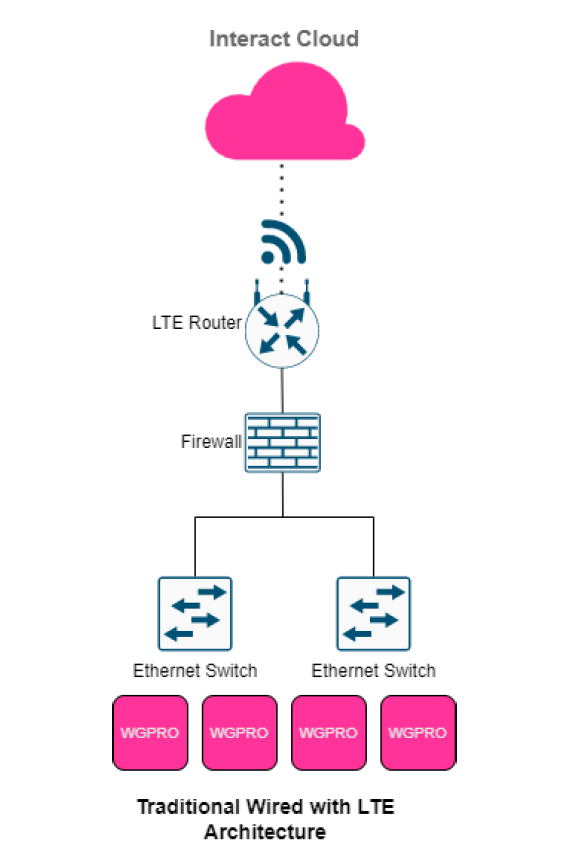
Option 2: LTE per Gateway Architecture (Metrics Disabled)
This architecture is meant to be used with metrics disabled. It is ideal for industrial sites where there are IT budget restrictions (offsetting long cable run costs). This option will facilitate firmware updates while maintaining operational features. Even though it is technically possible to be used with metrics enabled, this is not recommended. It is a low-data and low-cost solution, with the added benefit of firmware updates.
In this option, there is a single LTE router and subscription per each Wireless Gateway - called LTE per Gateway Architecture. This is used for situations where it is not possible to connect the Wireless Gateways physically either due to site-related issues or budget restrictions. The Wireless Gateways are completely independent from each other in segregated networks and connect directly to the Interact Cloud.
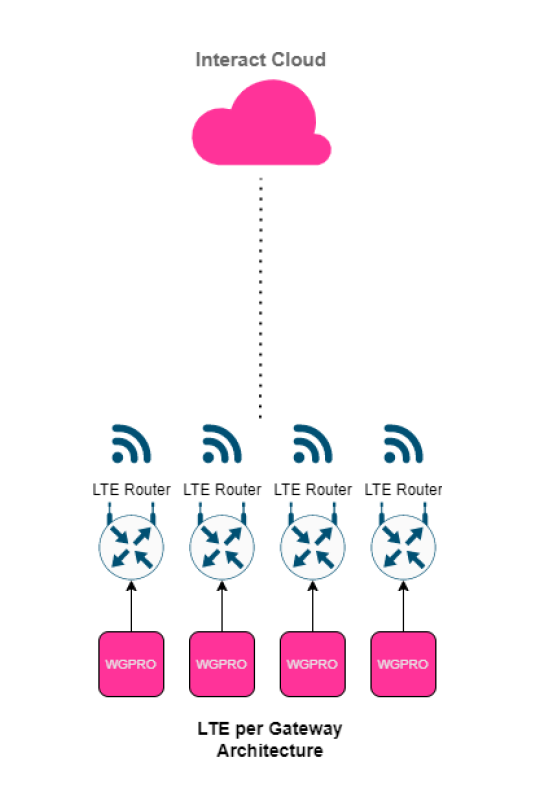
Option 3: LTE with Gateway Clusters (Metrics Enabled)
This architecture is typically used for situations where physically connecting every single Wireless Gateway is not possible either due to site-related issues or budget restrictions, and when the customer opts for the added value of metrics enabled. Creating clusters will optimize the number of required LTE routers and subscription fee per site as well.
In this option, there is one LTE router with four network ports and a single subscription per cluster of up to four gateways, called LTE with Gateway Clusters Architecture. Like in the LTE per Gateway Architecture, this option allows to select a favorable data subscription fee from one to a maximum of four Wireless Gateways.
The Wireless Gateways are connected to the (maximum of) four ethernet ports of the LTE Router via copper links.
Distance between Wireless Gateways and LTE Router
The LTE Router is placed next to the Wireless gateway in a LTE per Gateway Architecture. For LTE with Gateway Clusters architecture, however, there is a limitation of 100 m (328 ft) on traditional copper media. The LTE router only has RJ45 ethernet ports, therefore fiber connections are not possible.
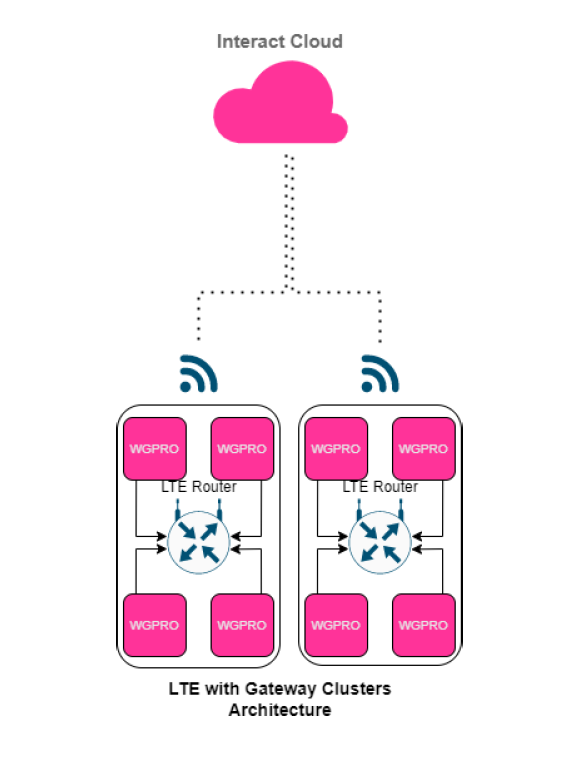
Technical Requirements
Prerequisites
Prior to accepting the use of LTE, a site survey is required. The customer site must have mobile network coverage inside the building to achieve the minimum speed. This can be done using a mobile device and a speed test application using the same Service Provider as the LTE subscription that is going to be used to connect the system. Please be aware that the location of the router may have an affect on the LTE coverage. An alternative location may be required, and it is also possible to add an exterior LTE antenna to the LTE router for extra gain.
Here are some examples. This one, just below, has a magnetic foot. Very useful in industrial environments where metal construction is used to stick the antenna to the construction without having to drill holes.
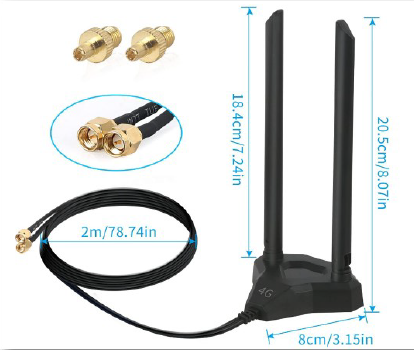
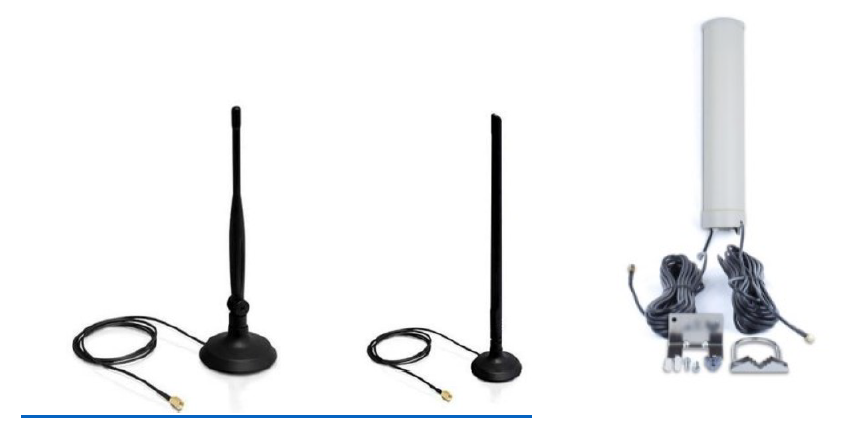
Network communication requirements
The Wireless Gateway communicates to the cloud via the IT network of the IPv4 used by the customer.
The communication between the Wireless Gateway and the cloud requires HTTPS, which uses the standard TCP-port 443. This port is commonly used for accessing the internet via a web browser.
Summary of requirements to connect the system:
-
Ethernet port with live LAN, connected with the IT network of the customer
-
IPv4 via DHCP server available
-
Port TCP 80 and 443 opened on the router
-
Port UDP 123 opened on the router
If firewalls are used to protect the network of the end customer, it is necessary to make sure that the following hosts can be connected to:
-
sme.interact-lighting.com:80
-
sme.interact-lighting.com:443
-
web.mqtt.pro.interact-lighting.com:443
Cloud Infrastructure uses dynamic IP addressing for scalability and availability reasons; therefore Firewalls must accept FQDN whitelisting.
If the gateway refuses to get connected (all 3 led’s solid blue), make sure that your network is not filtering access to the network via (for example) MAC address filtering or firewall filtering. Many other things can be the cause, like IP conflicts, multiple DHCP servers active etc. Consult your IT partner if the router is managed by someone else, to fix this.
See also the online network requirements on the portal under IT configuration → IT network requirements → Network requirements. It is required to login to the portal to check these requirements.
Validated Devices per Architecture
-
Traditional Wired LTE Architecture: It is possible to add an LTE Router to the existing architecture building blocks (available in the IT Guide), either provided by the customer (installation and maintenance is the customer’s responsibility) or by the Signify. The additional validated routers are Teltonika TRB140 (TRB254 for North America), Teltonika RUTX09, Cisco IR1101-K9 and Cisco IR1821-K9. It is also possible to use an LTE version of a validated Cisco C1111. The C1111-4PLTE has four ethernet ports and the C1111-8PLTE has eight ethernet ports.
LTE per Gateway Architecture:
-
Teltonika TRB140 (TRB254 for North America) has a single ethernet port to directly connect to a Wireless Gateway.
LTE with Gateway Clusters Architecture:
-
Teltonika RUTX09 has four ethernet ports to connect to four Wireless Gateway.

- Note
-
All Teltonika LTE Routers require an additional Remote Management System license. Teltonika TRB245 only has a Fast Ethernet (100Mb) port, which is the same as the Wireless Gateway.
LTE Requirements
-
Minimum speed: 2Mbps
-
Recommended speed: 5Mbps
-
Recommended RSSI: -70 dBm to -85 dBm (Please refer to LTE Signal Strength Guide table)
-
Recommended Data bundle with Metrics Enable, per cluster/site:
-
Either Unlimited bandwidth p/m OR
-
A more economical package with limited bandwidth (*)
-
-
Recommended Data bundle with Metrics Disabled, per gateway: 1Gb per month
-
please use the "PRE data usage calculator” to determine upper limit of bandwidth requirement.
-

For additional information regarding Data Requirements, check the Data consumption reference table for different project size examples (referring to the number of light points as guidance), or use the PRE Data Calculator tool available in the SNS Portal. This calculator is merely an indication of data usage and based on the number of sensor nodes. The type of sensors used and the number of light points might result in different data consumption.
BACnet network integration with PRE over LTE
Integration over BACnet is supported only by the Traditional Wired LTE Architecture. LTE per Gateway or LTE with Gateway Clusters Architectures do not support BACnet integration. Integration over Interact Cloud API (Application Programming Interface) remains possible for all LTE architectures.
Recommended tools
-
Nperf: https://www.nperf.com/en/map/NL/-/-/signal/ - Mobile Network Coverage tool, also available for Apple and Android devices.
-
Ookla Speedtest: https://www.speedtest.net/ - Speed test tool to be run on devices connected to a mobile internet connection to test site’s internet speed, also available for Apple and Android devices.
- Note
-
Be aware that sufficient power outlets must be provided for the combined router/WGPro solution.
LTE Ownership Models
Signify Delivered Hardware and LTE Subscriptions
-
Signify Delivered Hardware:
-
Cisco ISR
-
Teltonika TRB
-
Teltonika RUTX
Signify owns and maintains the hardware and licenses, like in traditional network deployments.
Signify Delivered LTE Subscriptions
No LTE Subscriptions are delivered by the Signify. Currently, Signify is not delivering any LTE subscriptions to any market. LTE subscription should be arranged by the customer.
Customer Delivered Hardware and LTE Subscriptions
Customer Delivered Hardware:
-
Customer can use Signify’s validated devices
-
Any LTE router that meets the requirements
The customer owns and is responsible for maintaining the hardware, it is advised to use the validated devices. It is possible to use other LTE routers if they meet the IT and LTE requirements, please check the SNS Portal for the full IT Guide.
Customer Delivered LTE Subscriptions:
-
Low data bundle for LTE per Gateway Architecture (Metrics Disabled)
-
Mid-High data bundle for LTE with Gateway Clusters Architecture (Metrics Disabled)
-
Unlimited data bundle for Traditional Wired LTE Architecture, LTE per Gateway Architecture and LTE with Gateway Clusters (Metrics Enabled)
- NOTE
-
The customer owns and is responsible for maintaining the LTE subscription should have enough data bundle for the desired architecture. We advise subscriptions to Unlimited data when metrics are enabled.